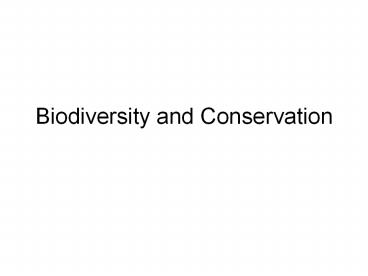Biodiversity%20and%20Conservation - PowerPoint PPT Presentation
Title: Biodiversity%20and%20Conservation
1
Biodiversity and Conservation
2
Biodiversity and Conservation
Chapter 5
5.1 Biodiversity
What is biodiversity?
- Biodiversity is the variety of life in an area
that is determined by the number of different
species in that area.
- Biodiversity increases the stability of an
ecosystem and contributes to the health of the
biosphere.
3
Biodiversity and Conservation
Chapter 5
5.1 Biodiversity
The Importance of Biodiversity
- Most of the worlds food crops come from just a
few species.
Teosinte plant
Domestic corn plant
4
Biodiversity and Conservation
Chapter 5
5.1 Biodiversity
- Scientists continue to find new extracts from
plants and other organisms that help in the
treatment of human diseases.
Madagascar periwinkle
5
Biodiversity and Conservation
Chapter 5
5.1 Biodiversity
- A healthy biosphere provides many services to
humans and other organisms that live on Earth.
- Natural processes provide drinking water that is
safe for human use.
6
Biodiversity and Conservation
Chapter 5
5.2 Threats to Biodiversity
Extinction Rates
- The gradual process of species becoming extinct
is known as background extinction.
- Mass extinction is an event in which a large
percentage of all living species become extinct
in a relatively short period of time.
7
Biodiversity and Conservation
Chapter 5
5.2 Threats to Biodiversity
8
Biodiversity and Conservation
Chapter 5
5.2 Threats to Biodiversity
Factors that Threaten Biodiversity
- The current high rate of extinction is due to the
activities of a single speciesHomo sapiens.
- Humans are changing conditions on Earth faster
than new traits can evolve to cope with the new
conditions.
9
Biodiversity and Conservation
Chapter 5
5.2 Threats to Biodiversity
Overexploitation
- Overexploitation, or excessive use, of species
that have economic value is a factor increasing
the current rate of extinction.
- Bison
- Passenger pigeons
- Ocelot
Rhinoceros
- Rhinoceros
Ocelot
10
Biodiversity and Conservation
Chapter 5
5.2 Threats to Biodiversity
Habitat Loss
- If a habitat is destroyed or disrupted, the
native species might have to relocate or they
will die.
Destruction of Habitat
- The destruction of habitat, such as the clearing
of tropical rain forests, has a direct impact on
global biodiversity.
11
Biodiversity and Conservation
Chapter 5
5.2 Threats to Biodiversity
Pollution
- Pollution and atmospheric changes threaten
biodiversity and global stability.
- Biological magnification is the increasing
concentration of toxic substances in organisms as
trophic levels increase in a food chain or food
web.
12
Biodiversity and Conservation
Chapter 5
5.2 Threats to Biodiversity
Acid Precipitation
- Sulfur and nitrogen compounds react with water
and other substances in the air to form sulfuric
acid and nitric acid.
- Acid precipitation removes calcium, potassium,
and other nutrients from the soil, depriving
plants of these nutrients.
Assessing Water Quality
13
Biodiversity and Conservation
Chapter 5
5.2 Threats to Biodiversity
Eutrophication
- Eutrophication occurs when substances rich in
nitrogen and phosphorus flow into waterways,
causing extensive algae growth.
- The algae use up the oxygen supply during their
rapid growth and after their deaths during the
decaying process.
- Other organisms in the water suffocate.
14
Biodiversity and Conservation
Chapter 5
5.2 Threats to Biodiversity
Introduced Species
- Introduced species often reproduce in large
numbers because of a lack of predators, and
become invasive species in their new habitat.
15
Biodiversity and Conservation
Chapter 5
5.3 Conserving Biodiversity
Natural Resources
- The consumption rate of natural resources is not
evenly distributed.
16
Biodiversity and Conservation
Chapter 5
5.3 Conserving Biodiversity
- Resources that are replaced by natural processes
faster than they are consumed are called
renewable resources.
- Resources that are found on Earth in limited
amounts or those that are replaced by natural
processes over extremely long periods of time are
called nonrenewable resources.
17
Biodiversity and Conservation
Chapter 5
5.3 Conserving Biodiversity
- Sustainable use means using resources at a rate
in which they can be replaced or recycled while
preserving the long-term environmental health of
the biosphere.
18
Biodiversity and Conservation
Chapter 5
5.3 Conserving Biodiversity
Biodiversity Hotspots
- At least 1500 species of vascular plants are
endemic.
- The region must have lost at least 70 percent of
its original habitat.
- These hot spots originally covered 15.7 percent
of Earths surface, however, only about a tenth
of that habitat remains.
Visualizing Biodiversity Hot Spots
19
Biodiversity and Conservation
Chapter 5
5.3 Conserving Biodiversity
Corridors Between Habitat Fragments
- Improve the survival of biodiversity by providing
corridors, or passageways, between habitat
fragments
- Creates a larger piece of land that can sustain a
wider variety of species and a wider variety of
genetic variation
20
Biodiversity and Conservation
Chapter 5
5.3 Conserving Biodiversity
Restoring Ecosystems
- The larger the affected area, the longer it takes
for the biological community to recover.
21
Biodiversity and Conservation
Chapter 5
5.3 Conserving Biodiversity
Bioremediation
22
Biodiversity and Conservation
Chapter 5
5.3 Conserving Biodiversity
Biological Augmentation
- Adding natural predators to a degraded ecosystem
is called biological augmentation.
Ladybugs help control aphid populations. Photo
courtesy of Natures Control

